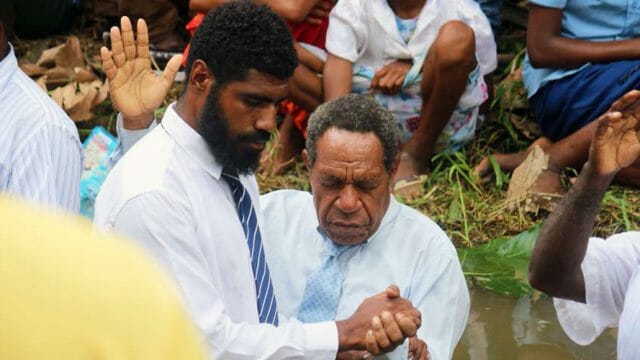Only following Jesus’ guidance can take us safely through the storms of life.

I will never forget reporting on the Toowoomba Pathfinder Camporee in Australia in January 2011. Now, in my experience, there seems to be some unwritten rule that whenever you go camping, it will rain. There seems to be no escaping it. But the rain at that camporee was different — it was next level. You may remember the headlines — an “inland tsunami” had swept through the town of Toowoomba.
It was unexpected. It was frightening. Lives were lost in the community.
I remember being out during the day, taking photos when the storm hit. We sheltered where we could, talked with people, and documented how they were coping. Some camps on lower ground were taking the weather poorly, and kids were sheltering in sheds with all their stuff. Lines of food were being distributed as many cook tents had been knocked over or were soggy wrecks. When I got a break, I ran over to check my own gear. I’d been assigned a camp bed in a shed with other camporee staff.
I couldn’t believe my eyes when I arrived. Wading through the shed, I soon realized there was nothing I could do there. The water was lapping just under my mattress. Thankfully my bedding and all my clothes were dry — for some reason I’d placed everything on my bed that morning when I got up (I was probably thinking about creepy-crawlies, not water). The water was still rushing, but at least my belongings were dry.
It came up so quickly. It went into unexpected places. It went everywhere. High ground, solid ground was most important.
That’s the thing about floods. They come without warning. They don’t always affect the same place or go where they are expected. You can’t just deal with it on the fly and make changes as you go.
Jesus knew the damage of flooding. Perhaps He’d seen some flash flooding around His home as a boy. He may have helped His father do the carpentry work on houses being built and would have discussed suitable locations, spending time around the Sea of Galilee. Too close to the sea and the sandy soil, they would not have been stable enough. “Nice view of the ocean . . . until you’re sliding into it.”
Jesus knew that if people followed His Way, they would encounter floods that could wash away their faith, unexpected and dangerous events that they needed to be prepared for.
And so, He told the story of the wise and foolish builders.
A Sermon Illustration for the Ages
Jesus has just finished His most famous sermon, known as the Sermon on the Mount. Both Matthew and Luke include versions of His teachings compiled in this discourse, and these teachings are incredibly challenging, countercultural, and deeply personal. He takes everything we knew about God and the practice of religion and calls us back to the core principles, and centralizes love of God and love of others.
“In the Sermon on the Mount [Jesus] sought to undo the work that had been wrought by false education, and to give His hearers a right conception of His kingdom and of His own character. Yet He did not make a direct attack on the errors of the people. He saw the misery of the world on account of sin, yet He did not present before them a vivid delineation of their wretchedness. He taught them of something infinitely better than they had known. Without combating their ideas of the kingdom of God, He told them the conditions of entrance therein, leaving them to draw their own conclusions as to its nature.”1
Right at the end of this sermon, Jesus uses the parable as an encouragement and as a warning.
As so many of Jesus’ parables do, He sets up a contrast of behavior. One man builds his house on a firm foundation, one man who doesn’t. Both build the same house, use the same techniques, and work hard. Those listening would have imagined the common houses that they knew and lived in. They had probably taken part in building their own family house or helped renovate and repair it. They knew how they were constructed and what it took.
Are they the foolish or the wise builder? And what determines the difference? Dietrich Bonhoeffer, in The Cost of Discipleship, suggests the first step is putting into practice what has been heard: “The only proper response to this word which Jesus brings with him from eternity is simply to do it. . . . Only in the doing of it does the word of Jesus retain its honour, might and power among us. Now the storm can rage over the house, but it cannot shatter that union with him, which his word has created.”2
Those in the crowd have just heard the Kingdom Manifesto. They have the blueprint to the kingdom. They have an invitation to be part of God’s great experiment: His new temple built out of humans. Now they are urged to implement those principles.
Jesus explains the parable Himself: “Therefore, whoever hears these words of mine and puts them into practice is like . . . ” (Matthew 7:24, NIV).
So, in one sense, the story is just about making a good decision. To follow Jesus’ teachings is a good decision, like building in the right place, meaning your house will be safe. The decision to disregard Jesus’ words is not just foolish but dangerous. There will be no protection against the storm.
But on another level, it is the union with Jesus, the foundation on the Rock, that seems to make the difference.
I wonder if those listening to Him thought of Psalm 18:2: “The Lord is my rock, and my fortress, and my deliverer; my God, my strong rock, in him will I trust; my shield and the horn of my salvation, my high tower” (ERV).3
This is an old concept. The Rock, the unchanging God who called Israel to live in covenant relationship with Him, was now reminding them where their house must be built.
The principles outlined by Jesus in His sermon are world-changing. They are good and can be accepted and debated by scholars and lay people alike. Many may choose to see Jesus as a good teacher and His principles as having philosophical, physical, or mental benefits. But Jesus doesn’t want His hearers to miss the point that their base must be His Divine Person.
Jesus was also familiar with the Jewish understanding of the “chaos waters” (see Genesis 1). In Jewish thought, the chaos waters of Genesis 1 represent pre-creation, opposition to God’s good order, and death. Water is a constant theme running throughout the Bible (water to wine, Jesus on the Sea of Galilee, John 4). The strong foundation mentioned by Jesus is reminiscent of God calming and confronting the chaos waters. Without that good foundation (parallel with God’s good creation power), the chaos waters run rampant and wash away the faith of the believer.
Our beliefs change; our cultural religious practices change (although some fight every change). Over the course of my life, I have seen my own beliefs grow. While that can be a challenging experience at times, the storms and floods of life are going to come up against us in life. If the recent COVID-19 pandemic has taught the church anything, it is that difficult circumstances force change and evolution through necessity. But the house that stays standing is the one that is firmly founded on Jesus. And He does not change (Hebrews 13:8, Malachi 3:6).
So how does the parable of the wise and foolish builders help me to live in Jesus’ kingdom? It reminds me I must look for opportunities to implement the building tips and blueprints that Jesus has outlined in His teachings, especially His Sermon on the Mount.
“In the sermon on the mount, Jesus gave his followers the call to radical love. A love that extends even to our enemies. This is not an anything-goes love, or a soppy, doe-eyed love that doesn’t see reality. It’s a principled recognition of the value and worth of the other,” writes Bruce Manners in his book, The Command.4
Life throws us storms that we must weather. There is no getting around that. I’ve had my fair share in the past few years. But as doubts and questions swirl, one thing I’ve known without question is that the One who gave us the Sermon on the Mount loves me, and if I stay connected, He can see me through any flood or storm.
The original version of this commentary was posted on Adventist Record. Jarrod Stackelroth is editor of Adventist Record and Signs of the Times at Signs Publishing Company in Warburton, Australia.
________________________________
1. Ellen G. White, The Desire of Ages (Mountain View, CA: Pacific Press, 1898), 299.
2. Dietrich Bonhoeffer, The Cost of Discipleship (New York: Touchstone, 2021), 197.
3. English Revised Version, 1881.
4. Bruce Manners, The Command (Warburton, Australia: Signs Publishing, 2021).








